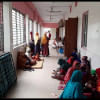Spending cuts in vital sectors will further hurt people

It is disappointing that the education and health sectors are once again set to get less Annual Development Plan (ADP) allocation than what has been prescribed in the 8th Five-Year Plan. Their apparent downgrading seems to have become a trend over the last four years, which is unfortunate. According to the draft development budget likely to be placed before the National Economic Council on May 16, the health sector will receive 7.8 percent of the ADP allocation in fiscal year 2024-25. However, the 8th Five-Year Plan for fiscal years 2020-21 to 2024-25 prescribed 11.1 percent of the ADP allocation for 2024-25. Similarly, the education and technology sector will get 13.7 percent of the ADP allocation against the plan's proposal of 16.5 percent.
As experts have noted, education and healthcare are two of the most vital sectors for human development. Despite policymakers—including the prime minister—repeatedly saying that they are putting more focus on these sectors, we hardly see a reflection of their commitments in the development budget. Without increasing investment in the two sectors, the country will not be able to properly develop its human resources. We are already struggling on that front, as evidenced by the number of experts our businesses have to hire from abroad leading to huge amounts of dollars leaving the country. Lack of investment also means that people's out-of-pocket expenditure for both healthcare and education will continue to remain high.
A review report placed before the Planning Commission in January found that out-of-pocket expenditure on healthcare in Bangladesh is around 72 percent, which is very high compared to our neighbouring countries including India, Bhutan, the Maldives, Pakistan, etc. There is a clear link between such high expenditures for people and a rise in poverty. Meanwhile, according to Unesco's Global Education Monitoring Report 2022, Bangladeshi families bear 71 percent of the total education expenditure in the country. For fixed-income and poor families, this means a disproportionate burden as well as disparity in the quality of education on offer.
Such inequalities should be addressed through proper government financing in education and healthcare. This is why the lack of sufficient budgetary allocation for the two sectors is a major concern. If the government cannot manage sufficient funds because of financial constraints, it has to come up with innovative measures to address the gap. Additionally, it has to increase the capacity of these two sectors—especially the relevant ministries—to absorb the necessary expenditure and utilise the allocations effectively.


 For all latest news, follow The Daily Star's Google News channel.
For all latest news, follow The Daily Star's Google News channel. 










Comments